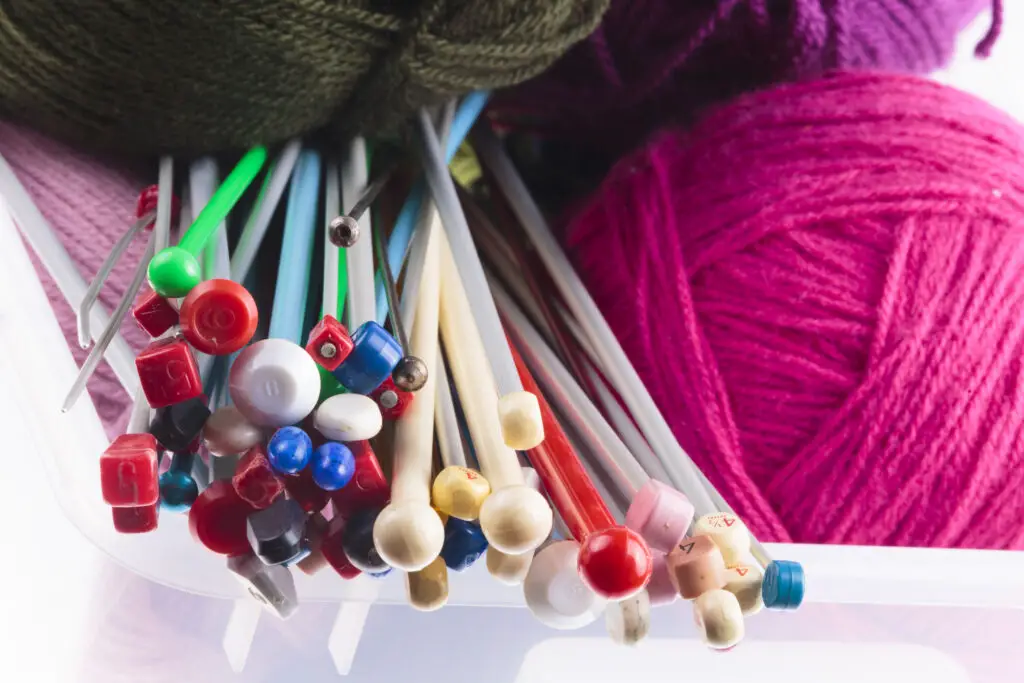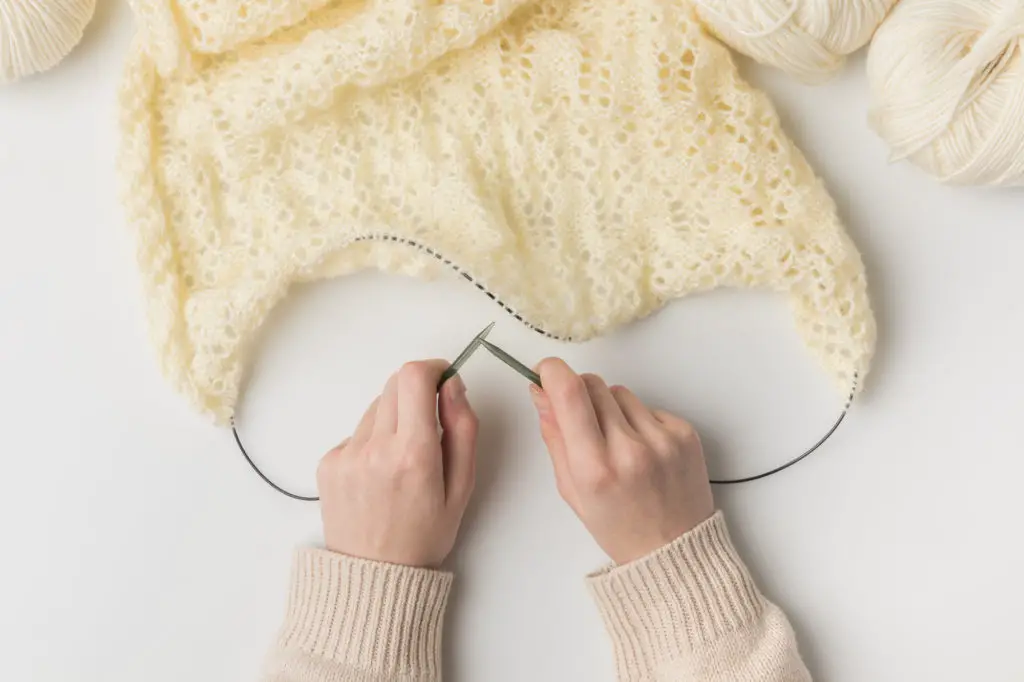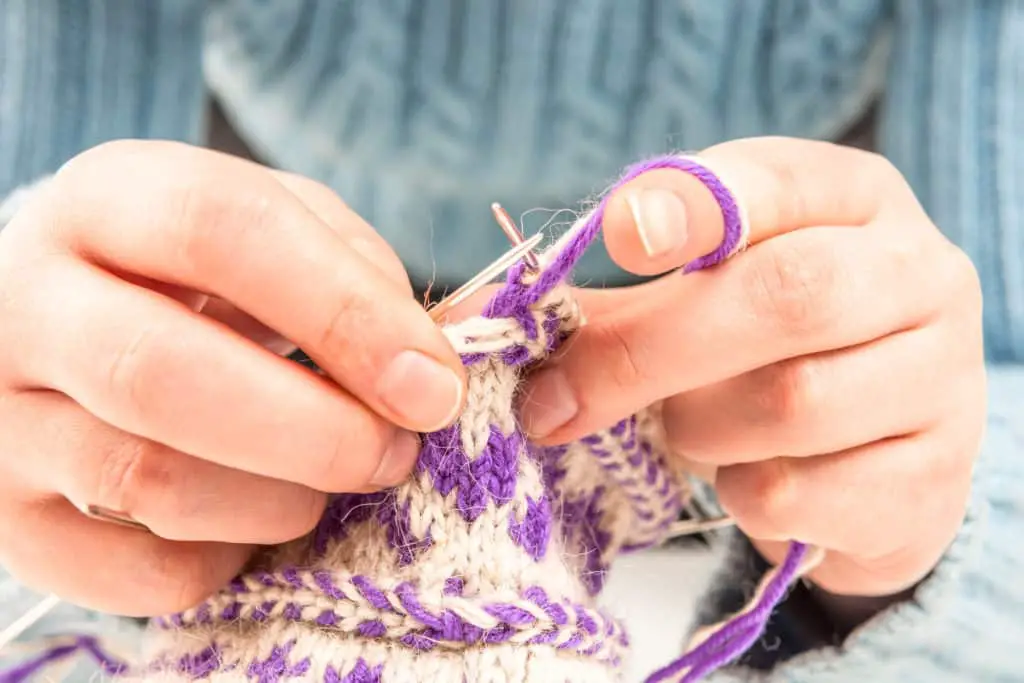Why Are Knitting Needles Different Sizes?
Knitting can be a great pastime that can allow you to develop your coordination skills and produce some cool-looking stuff. However, if you’ve ever spent any time in the knitting aisle at your local craft store, you’ve likely discovered there are a plethora of different sizes of needles in stock. Understanding the appropriate needle to use with each project can make or break the look of your final result.
Why Are Knitting Needles Different Sizes? Different projects require different size needles due to the yarn that is used. Generally, the larger the yarn, the bigger the needle size.

Let’s Talk Size
Knitting needles come in a variety of sizes, all of which are made for a specific purpose. These sizes are denoted by numbers with the smallest being the smallest needle. The smaller the needle you chose, the thinner the yarn will be that you’ll use for your desired project.
You’ll find knitting needles listed with both metric sizes and US sizes. It’s imperative that you pay close attention to what the size is stating as a 7 US is a much different size than a 7mm needle. You may from time to time also see UK sizes included in the needle marking which runs on an opposite system than the US. You can use online converters to understand what US size is equivalent to the metric or UK sizes if there is no US marking on the needle.
The project that you choose will dictate what particular size knitting needle you will need to use. If you’re new to knitting, you’re likely working from a pattern that will tell you which needle size is recommended. If you choose your yarn to work with first, you should find a recommended needle size on the packaging that works well for the weight of yarn that you choose.
- Aluminum knitting needle set comes with (3) sets of single-point 14 inch needles.
- These Boye knitting needles come in US Sizes 8, 9, and 10.
- These aluminum knitting needles are durable, lightweight, precisely sized, accurately balanced, and color-coded for easy size identification.
- Designed with perfection points help to prevent splitting of yarn.
- Our straight metal knitting needle kit is perfect for making scarves, leg warmers, ponchos, blankets, and more.
- MADE FROM HIGH BAMBOO.Made from bamboo- This fantastic set of knitting needles are made from bamboo which has been bleached for a smooth finish to avoid any rough edges. This process also makes then stronger than regular wooden hooks and mildew proof for lifelong quality assurance.
- HUGE SIZE RANGE- This set ticks all the boxes for its fantastic range of needle sizes .Size:2mm - 10mm
- GREAT FOR BEGINNERS- The needles supplied in this fantastic set are great for a beginner as all of the most popular sizes are provided to get you started on some basic projects. The smooth finish also helps to keep a smooth rhythm when following a pattern.
- SMOOTH AND LIGHT- One of the best benefits about using one of these sets of needles is that they are completely different to metal hooks. They are smoother and lighter which is great for those that suffer with joint pain as they require less tension and come with a handy thumb rest. The wooden quality and feel is always rated top by knitting and crochet enthusiasts!
- IT WORKS GREAT OR YOUR MONEY BACK - Try it out at our expense - If you are not fully satisfied, we will refund your money.CLICK the "ADD TO CART" button above to order yours now.
- Set includes: 13 pairs of 4 inch (10cm) aluminum circular knitting needles and 4 cables of different lengths (12.6 inches 15 inches 16.7 inches 21.6 inches) 4 needle holders, 2 cable keys, 2 couplers, 1 non-slip pad 15 marks (random color) buckle 1 leather bag.
- Knitting needles are made of light aluminum and oxidized to make them rust-free and durable. They have a purple leather carrying bag for easy carrying
- These knitwear are smooth and durable with no rough edges and can easily pass through the knitting needles. They come in different sizes and are clearly engraved on the knitting needle surface so that you can easily distinguish their sizes without rubbing off
- Needles of different sizes, connectors, wire connectors, and protective caps can be used freely in this set of braided needles. Be sure to use the attached cable key to secure the tip to the cable and make sure it fits tightly
- This knit kit can help you complete a variety of different projects you want to work on and is a great gift for your friends and family who love to knit
- Includes 1 ChiaoGoo Twist Red Lace Interchangeable Circular Knitting Needle Set Complete: US Sizes 2, 3, 4, 5, 6, 7, 8, 9, 10, 10.5, 11, 13, 15 (Metric 2.75, 3.25, 3.5, 3.75, 4.0, 4.5, 5.0, 5.5, 6.0, 6.5, 8.0, 9.0, 10mm) with 1 Craft Project Bag 7500-C
- Craft Project Bag measures 13 x 16 inches; includes a drawstring for easy closure and shoulder straps for easy carry-on and keeping projects on-the-go
- Set includes 6 cable lengths 3 for Small needles and 3 for Large needles: 14" (35cm), 22" (55cm), and 30" (75cm); 2 cable connectors (1 of each of Small & Large), 4 End Stoppers (2 each of Small & Large) and two tightening keys
- Set also includes 2 cord keys, needle gauge and 24 stitch markers (6 units of 4 styles) and a convenient cloth carry case
- PLEASE NOTE: Accessories are located in front, zippered pocket
Various Materials On The Market
Knitting needles can be made out of a variety of different materials. The most popular is made out of wood, more specifically bamboo. Others are made out of metals like aluminum and plastic. Choosing the particular material that you use for your knitting project will depend on your personal preference and a couple of other factors.
In general, newbies to the knitting world tend to work better with bamboo needles. This is because it’s much harder for the yarn to slip off of the needle and it causes a delay on the stitching. Those who are more experienced in this practice tend to opt for metal needles that provide a slipper base which allows their stitches to fly off of their needles.
Different Types Of Needles
It’s important to realize that knitting needles will come in different end offerings. There are five main needle ends which include circular, straight, interchangeable, cable, and double pointed. Circular needles tend to work for all types of projects and should be your go-to if you’re just starting out in the knitting world.
Straight needles are what most people picture when thinking about knitting needles. They’re great for smaller projects that require mostly flat work. Some examples of these include afghan squares, sweaters, scarves, and washcloths.
Larger knit projects can be completed more efficiently with circular needles. These are somewhat similar to the straight needles, except for the fact that they have a flexible cord that connects them. These are available in permanently joined needles or interchangeable pieces if you want to convert your straight needles. Ideal projects include blankets and shawls.

Double pointed needles are ideal for smaller projects that you’ll knit in the round. Their middle is flexible and can allow you to work with fewer needles throughout the entire project. Great projects for double pointed needles include hats, gloves, and mittens.
Cable needles look a bit odd at first but their benefit becomes clear as soon as you start your first stitch with them. This handy tool works great for keeping your active stitches safe while you’re moving your project around. These particular needles are perfect for creating a twist or cable in your project that allows it to stand out from a traditional knitting piece.
As with discussing the various needle types that are available on the market today, it’s also important to note the various point types. Most knitting needles have a point and it can make a big difference in the way that you knit.
Sharper points are great for stitching with a high level of accuracy when using fine yarn. Rounder pointed needles are great for your bulkier yarns and are recommended for children looking to take up this hobby.

The Nitty Gritty Of Needle Sizes
Now, you should have a fairly decent idea of the variations between knitting needles. You know what they’re made of, how they look, and why there are various sizes offered on the market today. Let’s take a look at the specific size offerings that are out there for you to choose from so you can get a better idea of what needle you should be using for your desired project.
Sizes 000 – 1
The tiny needles of the knitting world are meant for those who are regulars when it comes to producing materials. These are best utilized for projects that require intricate lace work or similar projects. These needle sizes can be harder to find as they’re more of a specialty item.
Sizes 1 – 3
When it comes to socks, this is the size to pick. Needles in this range are ideal for most of the stock yarn material that you’ll find at your local craft store. Socks, shawls, and blankets tend to be the ideal projects for this size of knitting needle.
Sizes 3 – 5
This needle size is best used with sport-weight yarn. Some popular projects with this needle size include sweaters, baby blankets, and more socks. This material is thicker than yarn handled by your lower sizes which makes it ideal for creating the cozy feel.
Sizes 5 – 7
Knitting needles in this size are perfect for DK-weight yarn. This is what you’re going to want to make your winter projects out of as they’re a much heavier material than others already listed above. Popular projects for this needle size include scarves, sweaters, and gloves.
Sizes 7 – 9
This is going to be the most popular knitting needle size that you’ll find both newbies and experienced knitters using. They get paired with worsted-weight yarn. This is the perfect combination for newbies to learn what they’re doing and be able to see their stitches.
Sizes 9 – 11
If you’re looking for quick knitting, then you need to get knitting needles in this size range. You’ll be working with chunky or bulky-weight yarn that is very famously known for being a quick knit yarn. It’s recommended to get yourself circular shaped needles when dealing with this heavier yarn as it will be a lifesaver to keep a hold of the yarn during your knitting practice.
Sizes 13 – 17
As you start to get into these bigger needle sizes, you’ll notice that there are only odd numbers. There are no even knitting sizes bigger than a 10. These bigger needles are preferable for heavy materials like cable.
Sizes Over 17
Any knitting needle over the size of 17 is intended for use with jumbo yarn. This is a newer weight category to hit the knitting market which is just starting to spark up in popularity. A good word of advice is to think about purchasing these jumbo needles in plastic as they’ll be much lighter to use than their metal alternatives.
In Conclusion
Knitting is a great way to relax and produce some handcrafted goods that you can be proud of. If you’re just getting started with this hobby, it’s important to understand the basics of knitting needles.
The above information should be enough to assist you in determining what needle sizes you’ll need to pick up and how to determine which size is best for each project that you decide to undertake in the future.



